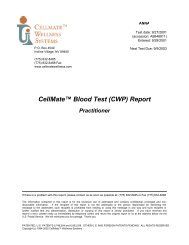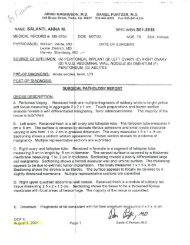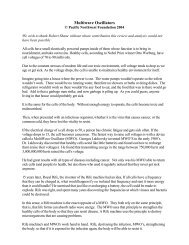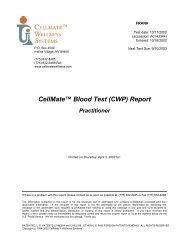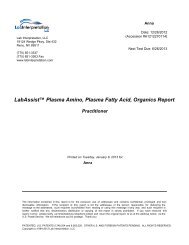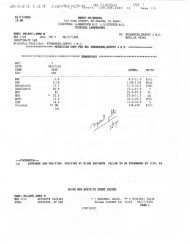LabAssist⢠Blood Test Report
LabAssist⢠Blood Test Report
LabAssist⢠Blood Test Report
- No tags were found...
Create successful ePaper yourself
Turn your PDF publications into a flip-book with our unique Google optimized e-Paper software.
Basic Status High/LowAnna Salanti <strong>Blood</strong> <strong>Test</strong> Date: 4/29/2009Female / Age: 57 Anna Salanti (2718)Client ID:555986644 (8322) 503-977-2660The % Status is the weighted deviation of the laboratory result.-200 -150 -100 -50 0-25%-100 -50 0 50 100-25% 25%Low Results% Status Result Low HighUltra-Sensitive TSH -127.86 L 0.01 1.10 2.50Basophil Count -44.30 L 11.40 0.00 200.00Basophils -40.00 L 0.20 0.00 2.00Lymphocyte Count -38.44 L 1202.70 850.00 3900.00Lymphocytes -32.06 L 21.10 15.00 49.00Anion Gap -30.00 L 10.40 8.00 20.00Thyroxine (T4) -30.00 L 6.10 4.50 12.50Free T4 Index (T7) -25.00 L 2.00 1.40 3.80High Results% Status Result Low HighLDL 89.71 H 157.00 62.00 130.00Glucose 61.76 H 103.00 65.00 99.00B.U.N./Creatinine Ratio 48.99 H 21.84 6.00 22.00Free T-3 39.47 H 400.00 230.00 420.00Uric Acid 38.89 H 6.50 2.50 7.00sGPT 35.29 H 35.00 6.00 40.00T-3 Uptake 34.62 H 33.00 22.00 35.00Hemoglobin 34.21 H 14.90 11.70 15.50Hematocrit 29.00 H 42.90 35.00 45.00MCH 27.25 H 31.63 27.00 33.00Calcium 25.00 H 9.80 8.60 10.20Chloride 25.00 H 107.00 98.00 110.00Copyright (c) 1994-2008 Crayhon Research, Inc. 4/30/2009 10:33 am Page 1
Basic Status AlphabeticAnna Salanti <strong>Blood</strong> <strong>Test</strong> Date: 4/29/2009Female / Age: 57 Anna Salanti (2718)The % Status is the weighted deviation of the laboratory result relative to the range.-100 -50 0 50 100-25% 25%% Status Result Low HighA/G Ratio 0.16 1.55 1.00 2.10Albumin 10.00 4.50 3.60 5.10Alkaline Phosphatase 9.79 91.00 33.00 130.00Anion Gap -30.00 L 10.40 8.00 20.00B.U.N. 16.67 19.00 7.00 25.00B.U.N./Creatinine Ratio 48.99 H 21.84 6.00 22.00Basophil Count -44.30 L 11.40 0.00 200.00Basophils -40.00 L 0.20 0.00 2.00Bilirubin, Total 0.00 0.70 0.20 1.20Calcium 25.00 H 9.80 8.60 10.20Calcium/Phosphorus Ratio 0.00 2.80 2.30 3.30Chloride 25.00 H 107.00 98.00 110.00Cholesterol 24.17 229.00 140.00 260.00CO2 0.00 27.00 21.00 33.00Creatinine 4.00 0.87 0.60 1.10Eosinophil Count -20.19 159.60 15.00 500.00Eosinophils -15.00 2.80 0.00 8.00Free T-3 39.47 H 400.00 230.00 420.00Free T4 Index (T7) -25.00 L 2.00 1.40 3.80GGT -12.69 28.00 3.00 70.00Globulin -8.82 2.90 2.20 3.90Glucose 61.76 H 103.00 65.00 99.00HDL-Cholesterol -24.55 51.00 37.00 92.00Hematocrit 29.00 H 42.90 35.00 45.00Hemoglobin 34.21 H 14.90 11.70 15.50Iron, Total 11.67 114.00 40.00 160.00LDH -11.54 170.00 120.00 250.00LDL 89.71 H 157.00 62.00 130.00Lymphocyte Count -38.44 L 1202.70 850.00 3900.00Lymphocytes -32.06 L 21.10 15.00 49.00MCH 27.25 H 31.63 27.00 33.00MCHC 18.30 34.73 32.00 36.00MCV 5.41 91.08 80.00 100.00Monocyte Count -15.11 461.70 200.00 950.00Monocytes 12.31 8.10 0.00 13.00Neutrophil Count -12.47 3864.60 1500.00 7800.00Neutrophils 20.95 67.80 38.00 80.00Phosphorus 0.00 3.50 2.50 4.50Potassium 0.00 4.40 3.50 5.30Protein, Total 7.14 7.40 6.20 8.30R.B.C. 20.00 4.71 3.80 5.10sGOT 6.00 24.00 10.00 35.00sGPT 35.29 H 35.00 6.00 40.00Sodium -4.55 140.00 135.00 146.00T-3 Uptake 34.62 H 33.00 22.00 35.00Thyroxine (T4) -30.00 L 6.10 4.50 12.50Triglycerides 20.67 106.00 0.00 150.00Ultra-Sensitive TSH -127.86 L 0.01 1.10 2.50Uric Acid 38.89 H 6.50 2.50 7.00W.B.C. -22.86 5.70 3.80 10.80Total Status Deviation 23.40Total Status Skew 3.13Copyright (c) 1994-2008 Crayhon Research, Inc. 4/30/2009 10:33 am Page 2
Client Summary ReviewAnna Salanti <strong>Blood</strong> <strong>Test</strong> Date: 4/29/2009Female / Age: 57 Anna Salanti (2718)Nutritional SupportThe following supplements may help to balance your biochemistry. Consult your practitioner.1-Cardiovascular Health Protocol 1-Increase Fluid IntakeSee Nutrition Detail 6-8 glasses daily1-Multivitamin w/Glucose Support 1-Oral Electrolyte - Standard Formula2x daily 2x daily3-Chromium Picolinate H - Billberry1x daily 200 mcg 1 - 3 times dailyH - Garlic H - Ginseng (Panax)1 - 3 times daily 1 - 3 times dailyH - Ginseng (Panax) H - Milk thistle1 - 3 times daily 1 - 3 times dailyH - Nettle1 - 3 times dailyNutritional Supplements to AVOIDThe following supplements may aggravate already out-of-balance biochemistry.Calcium Molybdenum SeleniumFood RecommendationsThe following foods may help to balance or strengthen your biochemistry.Apricots, Dried Artichoke Black Pepper CantaloupeCherries Eggs Grapefruit Green BeansGuava Haddock Halibut LoganberriesOnions Prunes Red Peppers ShellfishSwiss ChardFoods to AVOIDThe following foods may aggravate already out-of-balance biochemistry.Brazil Nuts Cucumber Dairy Products Hydrogenated FatsSoybeansCopyright (c) 1994-2008 Crayhon Research, Inc. 4/30/2009 10:33 am Page 3
Practitioner Summary ReviewAnna Salanti <strong>Blood</strong> <strong>Test</strong> Date: 4/29/2009Female / Age: 57 Anna Salanti (2718)Results Missing From <strong>Test</strong>A more comprehensive report would have been generated if the following results were provided.3-Methylhippurate Hippurate t,t-Muconic Acid MandelatePhenylglyoxylate Phthalate Quinolinate Monoethyl PhthalateOut-Of-Balance Panel ValuesThe following panels have a PSD of greater than 25% indicating need for further review. PSD is the Panel Status Deviation,or the average imbalance of that subset of results. The PSS is the Panel Status Skew, or the direction, negative (deficiency)or positive (excess), of that subset of results.Panel Name PSD PSSThyroid 51.39% -21.75%Lipid 39.77% 27.50%Nitrogen 27.14% 27.14%Cardiac Marker 26.65% 15.81%Differential Count 26.10% -26.10%Anti Oxidant Status 25.43% 15.43%Lab <strong>Report</strong>ed out-of-range ValuesThe following results are out-of-range (as reported by the lab), and should be carefully reviewed.Ultra-Sensitive TSH (-127.86%)TSH, produced by the anterior pituitary gland, causes the release and distribution of stored thyroid hormones. When T4and T3 are too high, TSH secretion decreases. When T4 and T3 are low, TSH secretion increases. Decreased levels ofTSH are seen in hyperthyroidism and secondary and tertiary hypothyroidism.Drugs which may have an adverse affect:Anabolic Steroids, CorticosteroidsLDL ( 89.71%)LDL is the cholesterol rich remnants of the lipid transport vehicle VLDL (very-low density lipoproteins). There have beenmany studies showing correlations between high levels of LDL and arterial artherosclerosis. Due to the expense of directLDL measurement, a calculation known as the Friedewald formula is used (Total Cholesterol - HDL Cholesterol -Triglycerides/5). When Triglyceride levels are greater than 400, this method is not accurate. Increased levels are seen inhigh cholesterol diets, nephrotic syndromes, multiple myeloma, hepatic obstruction or disease, anorexia nervosa,diabetes, chronic renal failure, and premature coronary heart disease.Drugs which may have an adverse affect:ClofibrateGlucose ( 61.76%)Glucose, formed by the digestion of carbohydrates and the conversion of glycogen by the liver, is the primary source ofenergy for most cells. Insulin, glucagon, thyroid hormone, liver enzymes, and adrenal hormones regulate it. It is elevatedin diabetes, liver disease, obesity, pancreatitis, steroids, stress, or diet.Drugs which may have an adverse affect:Acetaminophen, Acetazolamide, ACTH, Albuterol, Amitriptyline, Aspirin, Chlorpromazine, Clonidine, Corticosteroids,Cortisone, Dextrothyroxine, Epinephrine, Estrogens, Furosemide, Gemfibrozil, Haloperidol, Hydralazine, Imipramine,Indomethacin, Levodopa, Lithium Carbonate, Mercaptopurine, Methyldopa, Morphine, Nifedipine, Nitrofurantoin,Phenelzine, Phenylbutazone, Phenytoin, Polythiazide, Pravastatin, Prednisone, Protriptyline, ReserpineAdditional <strong>Test</strong>sThe following additional lab tests may help in diagnosis.Consider ordering Environmental Pollutants Biomarker urine test.Rationale: % Status of Glucose is > 50%Consider ordering Free-T3, Free-T4, Total T4, T3-UptakeRationale: % Status of Ultra-Sensitive TSH is < -50%Copyright (c) 1994-2008 Crayhon Research, Inc. 4/30/2009 10:33 am Page 4
Practitioner Summary Review (continued)Anna Salanti <strong>Blood</strong> <strong>Test</strong> Date: 4/29/2009Female / Age: 57 Anna Salanti (2718)Additional <strong>Test</strong>s (continued)Consider ordering glycohemoglobinRationale: % Status of Glucose is > 50%Consider ordering PTH profileRationale: Panel Thyroid Status Deviation is > 50%Copyright (c) 1994-2008 Crayhon Research, Inc. 4/30/2009 10:33 am Page 5
Panel/Subset <strong>Report</strong>Anna Salanti <strong>Blood</strong> <strong>Test</strong> Date: 4/29/2009Female / Age: 57 Anna Salanti (2718)Adrenal FunctionCholesterol, Eosinophils, Eosinophil Count, Potassium, Sodium.This panel is meant to assess adrenal function. A deficiency inthis panel may indicate adrenal stress. The deviation was below25% so no abnormalities were found.PSD: 12.78PSS: -3.11AllergyEosinophils, Globulin, Lymphocytes[L], Monocytes, W.B.C..This panel is used to assess the individual's response to potentialallergens. Abnormalities in this panel may indicate the need foradditional allergy testing. The deviation was below 25% so noabnormalities were found.PSD: 18.21PSS: -13.29Anti Oxidant StatusAnion Gap[L], Bilirubin, Total, Chloride[H], Cholesterol, Glucose[H],Iron, Total.This panel profile may indicate that the patient needs to increasetheir intake of antioxidants and make appropriate lifestylechanges (smoking, alcohol, reduce stress, etc.). A varied, broadspectrum of antioxidants is preferable to one or two alone.PSD: 25.43PSS: 15.43Athletic PotentialB.U.N./Creatinine Ratio[H], Cholesterol, CO2, Creatinine, LDH,Potassium, Protein, Total, Sodium, HDL-Cholesterol.This panel is used to help assess athletic potential. Keeping thispanel in a normal range may be helpful in improving athleticperformance and reducing the risk of injury. The deviation wasbelow 25% so no abnormalities were found.PSD: 13.88PSS: 4.85Bone/JointAlbumin, Alkaline Phosphatase, Calcium[H], Neutrophils,Phosphorus, Protein, Total, Uric Acid[H].This panel may be helpful in assessing bone and joint health.Keeping the elements of this panel in a normal range may behelpful in reducing the risk of osteoporosis and other bone andjoint disorders. The deviation was below 25% so noabnormalities were found.PSD: 15.97PSS: 15.97Copyright (c) 1994-2008 Crayhon Research, Inc. 4/30/2009 10:33 am Page 6
Panel/Subset <strong>Report</strong>Anna Salanti <strong>Blood</strong> <strong>Test</strong> Date: 4/29/2009Female / Age: 57 Anna Salanti (2718)Cardiac MarkerCholesterol, GGT, Iron, Total, LDH, sGOT, Triglycerides, UricAcid[H], HDL-Cholesterol, LDL[H].The profile shown here indicates that this individual may be at agreater risk for coronary heart disease than the generalpopulation. A review of dietary, environmental and personalhabits should be done and appropriate lifestyle changes made. Ifboth triglycerides and cholesterol are elevated, a regime ofexercise and dietary changes are more likely to exhibit benefits.Cellular DistortionsAlkaline Phosphatase, Anion Gap[L], GGT, Iron, Total, LDH,Neutrophils, W.B.C..PSD: 26.65PSS: 15.81PSD: 17.07PSS: -4.95This panel may be helpful in determining the ability of the body toproperly produce healthy cells. The deviation was below 25% sono abnormalities were found.DifferentialBasophils[L], Eosinophils, Lymphocytes[L], Monocytes, Neutrophils.This panel may be helpful in assessing immune system health.Excesses or deficiencies in this panel may indicate acompromised immune system. The deviation was below 25% sono abnormalities were found.PSD: 24.06PSS: -10.76Differential CountBasophil Count[L], Eosinophil Count, Lymphocyte Count[L], MonocyteCount, Neutrophil Count.PSD: 26.10PSS: -26.10The negative Panel Status Skew may be due to the immunesystem being at rest if the Differential Panels Deviation is lessthan 25%, if it is higher than 25% than suspect a weakened orcompromised immune system.ElectrolyteCalcium[H], Chloride[H], CO2, Phosphorus, Potassium, Sodium.This panel is a representation of electrolyte balance in blood.Balance is critical in maintaining and achieving optimal health.The deviation was below 25% so no abnormalities were found.PSD: 9.09PSS: 7.58Copyright (c) 1994-2008 Crayhon Research, Inc. 4/30/2009 10:33 am Page 7
Panel/Subset <strong>Report</strong>Anna Salanti <strong>Blood</strong> <strong>Test</strong> Date: 4/29/2009Female / Age: 57 Anna Salanti (2718)Gastrointest. FunctionAnion Gap[L], Chloride[H], Cholesterol, CO2, Monocytes, Potassium,Sodium, Triglycerides, LDL[H].This panel may be helpful in assessing gastrointestinal health.Keeping the elements listed in a normal range may improvedigestion and metabolism of proteins, fats and carbohydrates.The deviation was below 25% so no abnormalities were found.PSD: 22.93PSS: 15.26HematologyHematocrit[H], Hemoglobin[H], MCH[H], MCHC, MCV, R.B.C.,W.B.C..The hematology panel assesses the production of red blood cellsand their function. The deviation was below 25% so noabnormalities were found.PSD: 22.43PSS: 15.90Inflammatory ProcessEosinophils, Globulin, LDH, Potassium, sGOT, sGPT[H],Triglycerides, Uric Acid[H], LDL[H], Monocytes.This panel may be helpful in assessing any inflammatoryprocesses that may be occuring in the body. The deviation wasbelow 25% so no abnormalities were found.PSD: 23.82PSS: 16.75Kidney FunctionAlbumin, B.U.N., B.U.N./Creatinine Ratio[H], Chloride[H], CO2,Creatinine, Glucose[H], Potassium, Protein, Total, Sodium.This panel may be helpful in assessing kidney function. It isimportant to keep the elements of this subset in balance to helpthe body eliminate waste material. The deviation was below 25%so no abnormalities were found.PSD: 17.81PSS: 16.90LipidCholesterol, Triglycerides, HDL-Cholesterol, LDL[H].The panel profile seen here suggests that the patient may be ata greater risk for coronary heart disease than the generalpopulation. A dietary evaluation should be undertaken as well toeducate the patient about saturated and trans fats.PSD: 39.77PSS: 27.50Liver FunctionAlbumin, Alkaline Phosphatase, Bilirubin, Total, Cholesterol, GGT,Protein, Total, sGOT, sGPT[H].Assessing liver function is important in determining theindividual's ability to detoxify itself as well as processing aminoacids and other important biological processes. The deviationwas below 25% so no abnormalities were found.PSD: 13.14PSS: 9.96Copyright (c) 1994-2008 Crayhon Research, Inc. 4/30/2009 10:33 am Page 8
Panel/Subset <strong>Report</strong>Anna Salanti <strong>Blood</strong> <strong>Test</strong> Date: 4/29/2009Female / Age: 57 Anna Salanti (2718)NitrogenB.U.N., B.U.N./Creatinine Ratio[H], Creatinine, Uric Acid[H].The panel profile seen here indicates the need for anassessment of the area of abnormality as well as ascertainingrenal function, dietary intake, dysbiosis, congestive heart failure(this list is not all-inclusive).PSD: 27.14PSS: 27.14ProteinA/G Ratio, Albumin, Globulin, Protein, Total.Proteins are the basic building blocks of hormones, muscle,neurotransmitters, immune systems responses and more.Assessing their competency is crucial in achieving optimalwellness. The deviation was below 25% so no abnormalitieswere found.PSD: 6.53PSS: 2.12Pulmonary FunctionAnion Gap[L], Calcium[H], CO2, LDH, Potassium, sGOT, Sodium.This panel may be helpful in assessing lung and respiratoryfunction. The deviation was below 25% so no abnormalities werefound.PSD: 11.01PSS: -2.15RatiosA/G Ratio, B.U.N./Creatinine Ratio[H], Calcium/Phosphorus Ratio,Sodium/Potassium Ratio.This panel may be helpful in determining the general balance ofthe overall chemistry of the individual. The deviation was below25% so no abnormalities were found.PSD: 12.67PSS: 11.91ThyroidFree T-3[H], Thyroxine (T4)[L], T-3 Uptake[H], Free T4 Index (T7)[L],Ultra-Sensitive TSH[L].This profile may indicate the need for a careful review of theindividual markers in order to determine causative factors.PSD: 51.39PSS: -21.75Copyright (c) 1994-2008 Crayhon Research, Inc. 4/30/2009 10:33 am Page 9
Drug InteractionsAnna Salanti <strong>Blood</strong> <strong>Test</strong> Date: 4/29/2009Female / Age: 57 Anna Salanti (2718)Drugs listed below tend to further aggravate elements of blood chemistry that are out of range (H or L). The(#) after each drug denotes the number of times that drug is flagged as being potentially harmful.ACTH Acetaminophen(3) Acetazolamide(3) AlbuterolAllopurinol Amitriptyline(2) Ammonium Chloride Ampicillin(2)Anabolic Steroids(3) Antacids Aspirin(6) BusulfanCarbamazepine Chlorothiazide Chlorpromazine(2) ClindamycinClofibrate(2) Clonidine(2) Codeine ColchicineCorticosteroids(4) Cortisone(3) Coumarin DesipramineDextrothyroxine Diazepam Epinephrine(2) ErythromycinEstrogens(2) Fluorides Fluphenazine FlurazepamFurosemide(3) Gemfibrozil Gentamicin(2) GriseofulvinGuanethidine(2) Haloperidol(2) Hydralazine(3) Hydrocortisone(2)Hydroxyurea(2) Ibuprofen(3) Imipramine(2) Indomethacin(3)Itraconazole(2) Kanamycin Ketocanazole Levodopa(3)Levothyroxine Lincomycin Lithium Carbonate(4) LovastatinMAO Inhibitors Mercaptopurine(3) Methimazole Methotrexate(2)Methyldopa(4) Morphine(2) Naproxen Nifedipine(2)Nitrofurantoin(2) Paramethadione Penicillamine PenicillinPhenelzine(3) Phenobarbital Phenylbutazone(4) Phenytoin(2)Piroxicam(2) Polythiazide(4) Pravastatin(3) Prednisone(4)Procainamide(2) Progesterone(2) Progestins(2) Propranolol(3)Protriptyline(2) Reserpine(2) Rifampin(3) Salicylates(2)Sildenafil(2) Simvastatin Spectinomycin SulfamethizoleSulfamethoxazole(3) Sulfasalazine Sulfisoxazole Tadalafil(2)Tamoxifen Tetracycline Triameterene TrimethadioneValproic Acid(2)Vardenafil(2)Copyright (c) 1994-2008 Crayhon Research, Inc. 4/30/2009 10:33 am Page 10
Nutrition - DetailAnna Salanti <strong>Blood</strong> <strong>Test</strong> Date: 4/29/2009Female / Age: 57 Anna Salanti (2718)Nutritional and herbal information contained in this report is based upon research related to imbalances in yourchemistry. The recommendations are based upon the information provided, without interpretation. This must bedone with the help of a qualified health care professional.1-Cardiovascular Health Protocol See Nutrition DetailCARDIOVASCULAR RISK PROTOCOLThis pattern indicates suboptimal operation of fat metabolism, interferingwith efficient cellular energy production. Various pathways being overorunder- utilized can be nutritionally supported with digestive enzymes,B-Complex, Lipoic acid, and CoEnzyme Q10 supplementation.Recommended nutrients include:B-Complex (2x daily)Lipoic Acid (2x daily)CoEnzyme Q10 (2x 50 mg daily)Digestive Enzymes (1-2 with each meal)Wallace, DC, Mitochondrial genetics: a paradigm for aging anddegenerative diseases?, Science, 256:628-632 (1992).Corral-Debrinski, Shffner JM, Lott MY, Wallace DC, Association ofmitochondrial DNA damage with aging and coronary artheroscleroticheart disease. Mutat Res, 275:169-180 (1992).RationaleDecreased Normal IncreasedCholesterolLDLHDL-Cholesterol Uric Acid1-Increase Fluid Intake 6-8 glasses dailyINCREASE FLUID INTAKEWhen the concentration of Hemoglobin, Hematocrit and Red <strong>Blood</strong> Cellsare increased, it is a good indicator of the need to increase fluid intake.Fluid intake should include a well rounded group of fluids including, butnot limited to water.Decreased Normal IncreasedR.B.C.HematocritHemoglobin1-Multivitamin w/Glucose Support 2x dailyMULTIVITAMIN - GLUCOSE SUPPORTA multivitamin with nutrients to help moderate glucose levels may behelpful in balancing your chemistry.Decreased Normal IncreasedTriglyceridesGlucose1-Oral Electrolyte - Standard Formula 2x dailyORAL ELECTROLYTEThe main electrolytes in the human body are sodium, potassium,phosphorus, calcium, chloride, magnesium and bicarbonate. Duringillness, the equilibrium present in healthy individuals, is disturbed. Awell balanced formula is helpful in restoring a state of equilibrium. Asports formula will have greater levels of bicarbonate yet still keeping theproportion of the other salts in line.Decreased Normal IncreasedPotassiumCO2Sodium3-Chromium Picolinate 1x daily 200 mcgCHROMIUM (Cr)Constituent of GTF (glucose tolerance factor), works with insulinpromoting glucose uptake. Functions in metabolism in nucleic acids,lipid metabolism, cholesterol and triglycerides.Decreased Normal IncreasedCholesterolGlucoseTriglyceridesH - Billberry 1 - 3 times dailyBILBERRYBillberry (Vaccinium myrtillus) is an herb often used for the control ofinsulin levels and may help halt or prevent macular degeneration. It hasalso been reported to be effective in lowering triglyceride levels. As withany herb, caution should be taken with its use. Bilberry also mayinterfere with iron absorption.Decreased Normal IncreasedIron, TotalGlucoseTriglyceridesCopyright (c) 1994-2008 Crayhon Research, Inc. 4/30/2009 10:33 am Page 11
Nutrition - DetailAnna Salanti <strong>Blood</strong> <strong>Test</strong> Date: 4/29/2009Female / Age: 57 Anna Salanti (2718)Nutritional and herbal information contained in this report is based upon research related to imbalances in yourchemistry. The recommendations are based upon the information provided, without interpretation. This must bedone with the help of a qualified health care professional.H - Garlic 1 - 3 times dailyGARLICGarlic's use has been reported to be beneficial in lowering blood lipid(fat) levels. May cause unwanted bodily odors. As with any herb, cautionshould be taken with its use.RationaleDecreased Normal IncreasedCholesterolLDLH - Ginseng (Panax) 1 - 3 times dailyGINSENGAlso known as Korean Ginseng (Panax ginseng), this herb has shownbenefits to those suffering from fatigue, stress, compromised immunesystems and diabetes. As with any herb, caution should be taken withits use. Women who experience breast tenderness should discontinueits use.Decreased Normal IncreasedGlucoseH - Ginseng (Panax) 1 - 3 times dailyGINSENGAlso known as Korean Ginseng (Panax ginseng), this herb has shownbenefits to those suffering from fatigue, stress, compromised immunesystems and diabetes. As with any herb, caution should be taken withits use. Women who experience breast tenderness should discontinueits use.Decreased Normal IncreasedLymphocytesLymphocyte CountH - Milk thistle 1 - 3 times dailyMILK THISTLEThe herb milk thistle (Silybum marianum) has been reported to beeffective in improving liver function. As with all herbs, caution should betaken with its use. Use only under the direction of a health carepractitioner if you have chronic liver disease.Decreased Normal IncreasedsGOTsGPTH - Nettle 1 - 3 times dailyNETTLEAlso known as stinging nettle, research has reported that this herb maybe helpful at reducing chlorides. It also has a mild diuretic effect andhas been used to relieve benign prostatic hypertrophy. As with all herbs,caution should be taken with its use.Decreased Normal IncreasedB.U.N.ChlorideAVOID THE FOLLOWING SUPPLEMENTSAVOID CalciumCALCIUM (Ca)Major cation partly responsible for cell membrane structure and functionrequired for cardiac contraction, regulates hormones, heart respiration,cell division and body fluid bufferings.AVOID MolybdenumMOLYBDENUM (Mo)Vital constituent of xanthine oxidase (uric acid production), aldahyde andsulfate oxidase. Functions in transfer of electrons for redox process andcompletion of sulfur amino acid catabolism. It is also iinvolved inhemoglobin synthesis. Molybdenum also inhibits absorption Cu and Fe.AVOID SeleniumSELENIUM (Se)Cofactor in glutathione peroxidase, in detoxification of peroxides, freeradicals and thyroid hormone deionases.Decreased Normal IncreasedCalciumDecreased Normal IncreasedUric AcidDecreased Normal IncreasedThyroxine (T4)T-3 UptakeCopyright (c) 1994-2008 Crayhon Research, Inc. 4/30/2009 10:33 am Page 12
Clinical CorrelationAnna Salanti <strong>Blood</strong> <strong>Test</strong> Date: 4/29/2009Female / Age: 57 Anna Salanti (2718)This report "MATCHES" clinical observations with the lab test. Elements shown, normal and abnormal, tend tocharacterize the observation. Highlighted elements are those reported to "MATCH" the characteristics of theclinical observation. Others are NOT matches but are elements in the observation.Review Cardiovascular Risk Factors () 66.67% (4 of 6)Decreased Normal Increased-24.55 HDL-Cholesterol 24.17 Cholesterol61.76 Glucose20.67 Triglycerides38.89 Uric Acid89.71 LDLReview family history or personal history of cardiovascular risk factors such as smoking, excessive alcoholintake, high fat diet, and/or sedentary lifestyle.Copyright (c) 1994-2008 Crayhon Research, Inc. 4/30/2009 10:33 am Page 13



